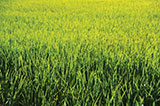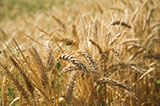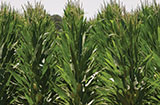Volume 32 · Number 1 · Fall 2014
Hot crops
Four hot crops
at a glance

Rice is the staple food for more than half the world’s population — especially important in Bangladesh, Asia and Southeast Asia.
Drought already affects more than 56 million acres of rice fields globally.
Farmers can boost rice yield by 50 percent using more drought-tolerant varieties, but more productive varieties still are desperately needed.

Wheat is the most widely grown cereal crop in the world, accounting for about 20 percent of what we collectively eat every day.
In developing regions, it’s second only to rice as a staple food.
In just 25 years, we’re expected to be globally clamoring for 60 percent more wheat than we’re now producing.
The peanut is crucial for the daily nutrition and livelihoods of millions of smallholder farmers in Asia and Africa, many of whom are women. Globally, farmers tend nearly 60 million acres of peanuts, annually producing about 44 million tons.
This oil- and protein-rich legume also is a major cash crop in the South and Southeast, making the U.S. the world’s third largest peanut-producing nation — right behind China and India.

Corn, or maize, is the top field crop in the U.S., where it is grown on 80 million acres — primarily for livestock feed.
This versatile crop also supplies food and food ingredients, biofuel and fiber around the world.
As the planet heats up, scientists work to adapt grains and legumes to help them—and us—thrive.
Sometimes it pays to have wild and quirky relatives. That’s certainly the case for staple crops that help feed the world. It also helps — both the plants and the people who depend on them — to have leading geneticists searching for family traits that could ensure those crops thrive in a warmer, drier world.
Researchers at UC Davis and around the world are scrambling to develop new varieties of food and fiber crops that will produce abundant yields despite drought and other effects of climate change. They’re also exploring more water-efficient ways to grow existing crops.
It’s estimated that 38 percent of the world and 70 percent of its agricultural output are already impacted by drought — numbers that will likely rise as climate change intensifies. To make matters worse, global population is spiraling upward, expected to soar past 9 billion by the year 2050.
In short, we’re headed toward a future that will have billions of more mouths to feed with much less water, higher temperatures and no room to expand the global farm.
To be sure, there is no “silver bullet” to take down the twin beasts of drought and climate change. Here’s why:
- It’s not just about developing less-thirsty crops. With reduced rain and irrigation water, you also get higher salt concentrations in the soil, meaning that many crops of the future will need to be salt-tolerant.
- And to dodge the warming temperatures, some crops now grown during the summer months will, in certain regions, become winter-season crops — meaning they’ll also have to get by on the shorter stretches of daylight that accompany winter.
Juggling, heat, light, salt and scarce moisture is a tall order, but scientists are already finding such multifaceted solutions in the genes of both domesticated plants and their ancestors.
With some plants, they’re searching for genetic “markers” that will identify the genes responsible for various stress-tolerance traits, speeding up conventional breeding. In other cases, they expect to insert genes from the wild relatives into existing crop varieties, better equipping them to adapt to climate change.
Here are snapshots of four crops and the scientists studying them:
Longer leaf life
To make rice around the world more tolerant of drought conditions, plant scientist Eduardo Blumwald and his lab colleagues are investigating rice genes that will delay “leaf senescence” — that normal phase when the older leaves begin to decline and the plant, like an aging factory, begins to shut down.
Blumwald and team hope to develop rice varieties that don’t rush quickly into senescence during drought conditions, but rather continue the leaf-based photosynthetic process that yields the nutrients necessary to make the rice grains.
“We are working against the clock.”
—Eduardo Blumwald, professor of plant sciences
Genomic giant
The wheat genome contains 16 billion base pairs — the molecules that make up DNA — and is five times the size of the human genome.
Plant geneticists Jorge Dubcovsky, Jan Dvorak and colleagues are mapping, isolating and cloning genes from the massive wheat genome, investigating the critical stages of the development cycle, including genes that impact a plant’s drought tolerance.
For example, genes that allow wheat to flower a few days early — saving precious irrigation water — could be used to develop new climate-flexible wheat varieties. Dubcovsky’s laboratory also has recently identified a region of a rye chromosome that, when introduced into wheat, increases yield and improves the water status of the plant under limited irrigation. Dvorak’s lab is working to develop salt-tolerant wheat that could be irrigated with poor-quality water, saving the better water for other uses.
“We are getting closer and closer to a crunch in our food supply, so we better have the genetic resources at hand if we want to continue improving wheat and feeding people.”
— Jorge Dubcovsky, plant geneticist and wheat genomics expert
Cracking a nutty puzzle
The commercially grown modern peanut emerged thousands of years ago from a natural hybrid fusion between two wild peanut ancestors, meaning that scientists find themselves studying something of a double genome.
Research scientist Lutz Froenicke in Professor Richard Michelmore’s laboratory at the UC Davis Genome Center developed “ultra-high density” genetic maps for the two peanut ancestor genomes.
These maps serve as frameworks for sorting the pieces of the legume’s genomic puzzle and then putting them back together at the chromosome scale, better equipping the world to make sure that peanuts keep producing as the climate changes.
Corn’s ancient lineage
Maize spans global cultures and eons of time, having been domesticated some 9,000 years ago from wild tiosente grasses in Mexico and elsewhere in Central America.
Plant geneticist Jeffrey Ross-Ibarra is studying the genetic diversity and domestication of maize, as well as maize breeding.
He’s particularly interested in how maize adapted from its origin in the lowlands of Mexico to growing in the high altitudes of Central and South America.
Genes for those adaptive traits might also prove invaluable in developing corn or maize varieties that can adjust to climate change.
Super staples
For millions of the world’s poorest people, who are the most vulnerable to famine, Simon Chan’s research offers hope for more resilient staple crops.
Until recently, ensuring a plant inherited its parents’ most valuable traits — such as drought tolerance or pest resistance — required generations of inbreeding. Chan’s “breeding true” discovery bypassed the laborious process.
With support from some of the most prestigious grants in science, Chan was working to apply his discoveries to staple foods of the world’s most impoverished regions. Just months after he received tenure in UC Davis’ plant biology department, however, he died from a rare autoimmune disease at the age of 38. Inspired by his commitment to mentoring students and his impact on modern agriculture, his colleagues launched the Simon Chan Memorial Endowment — with a generous gift from an anonymous donor — in order to realize the global potential of his work.
Read more about Chan’s life and work.
